Laurentian University is receiving $49.2 million from the federal government for a research project at the school's Mineral Exploration Research Centre.*
A sort of SNOLAB for the mining industry, the centre will research how precious metals formed during the Precambrian era, which covers the time period between the creation of the Earth about 4.5 billion years ago, until 600 million years ago.
The research is being described as one of the keys to discovering the next generation of mines in Canada.
“Metal Earth will transform our understanding of the genesis of base and precious metal deposits during Earth’s evolution,” says documents detailing the research. “It will make Canada a world leader in metal endowment research and world-class innovator through open source delivery of new knowledge and the implementation of new technology.”
The research will look at how the Earth evolved over those billions of years and how that process affected how precious metal deposits formed and, key to the mining industry, where they formed. It will also try to determine why some areas are mineral rich and some are not.
“Metal Earth will initially focus on the Precambrian era to answer fundamental questions related to how secular changes in Earth’s evolution have resulted in differential metal endowment in space and in time,” the documents say. “Research will seek to determine the geological, geochemical and geophysical differences between metal endowed, less endowed and the more common barren areas that appear geologically equivalent.”
Understanding that process could have major implications for mining, since it could help predict where other ore bodies are located.
“Through this new knowledge, Metal Earth will transform our understanding of Earth’s evolution and the fundamental processes that govern metal enrichment through time, as well as increase our understanding of the evolution of our planet’s hydrosphere and atmosphere,” the documents say. “New knowledge and technology generated by Metal Earth will become principal drivers to support Far North development, sustainability and sovereignty and will firmly place Canada as a global leader in Mineral Exploration research.
“The resource sector will benefit through direct application to geoscience surveys to focus exploration and increase discoveries. Recognition of key, measureable and validated criteria defining metal endowed areas is essential for the discovery of Canada’s next generation of mines.”
Laurentian applied for support from the Canada First Research Excellence Fund, one of 30 such proposals submitted in March. LU made it to the second round – one of 15 of the proposals to make it to the interview stage — and ultimately was selected to receive major funding.
That part of the process took place in July, with the funding for the project being confirmed in late August.
University officials said Friday they couldn't comment on the Metal Earth funding until full details are released. The official announcement will be made Tuesday at 1 p.m. at a news conference hosted by Sudbury MP Paul Lefebvre and Nickel Belt MP Marc Serré at the Willet Green Miller Centre at LU.
*An earlier version of this story contained some factual inaccuracies related to the amount of funding Metal Earth would receive. It also inaccurately referred to Metal Earth as a "facility," instead of a "project." Those errors have been corrected.
